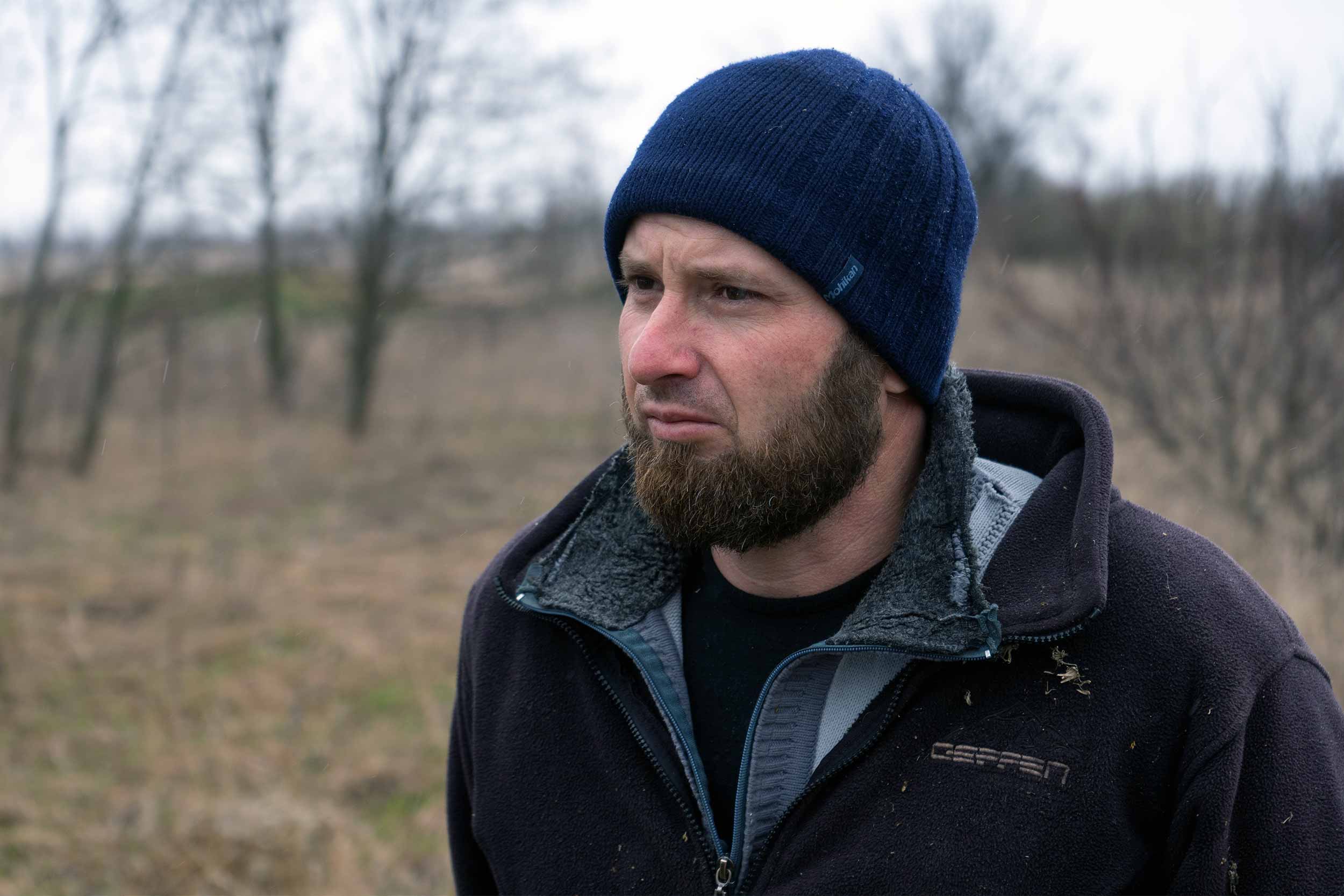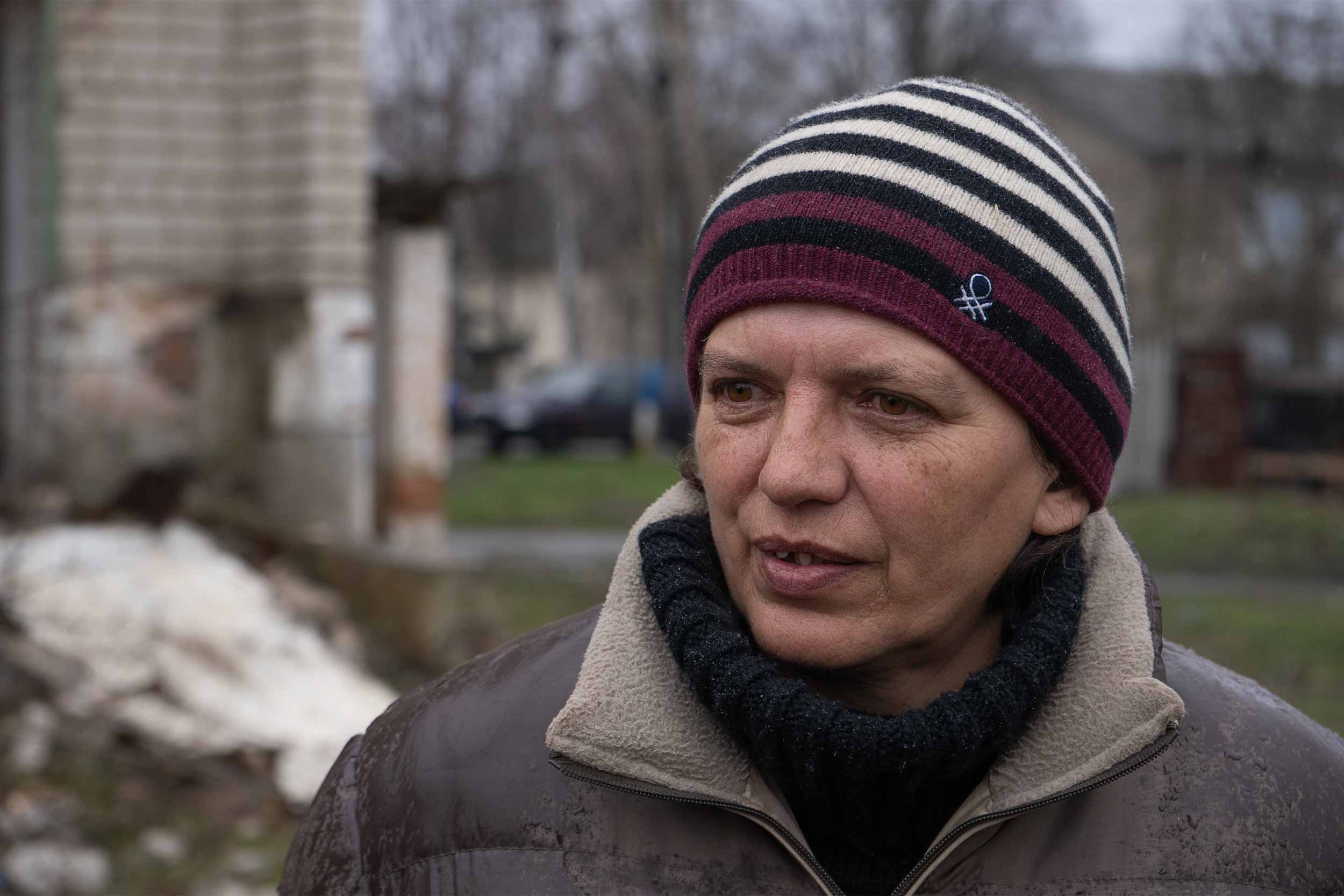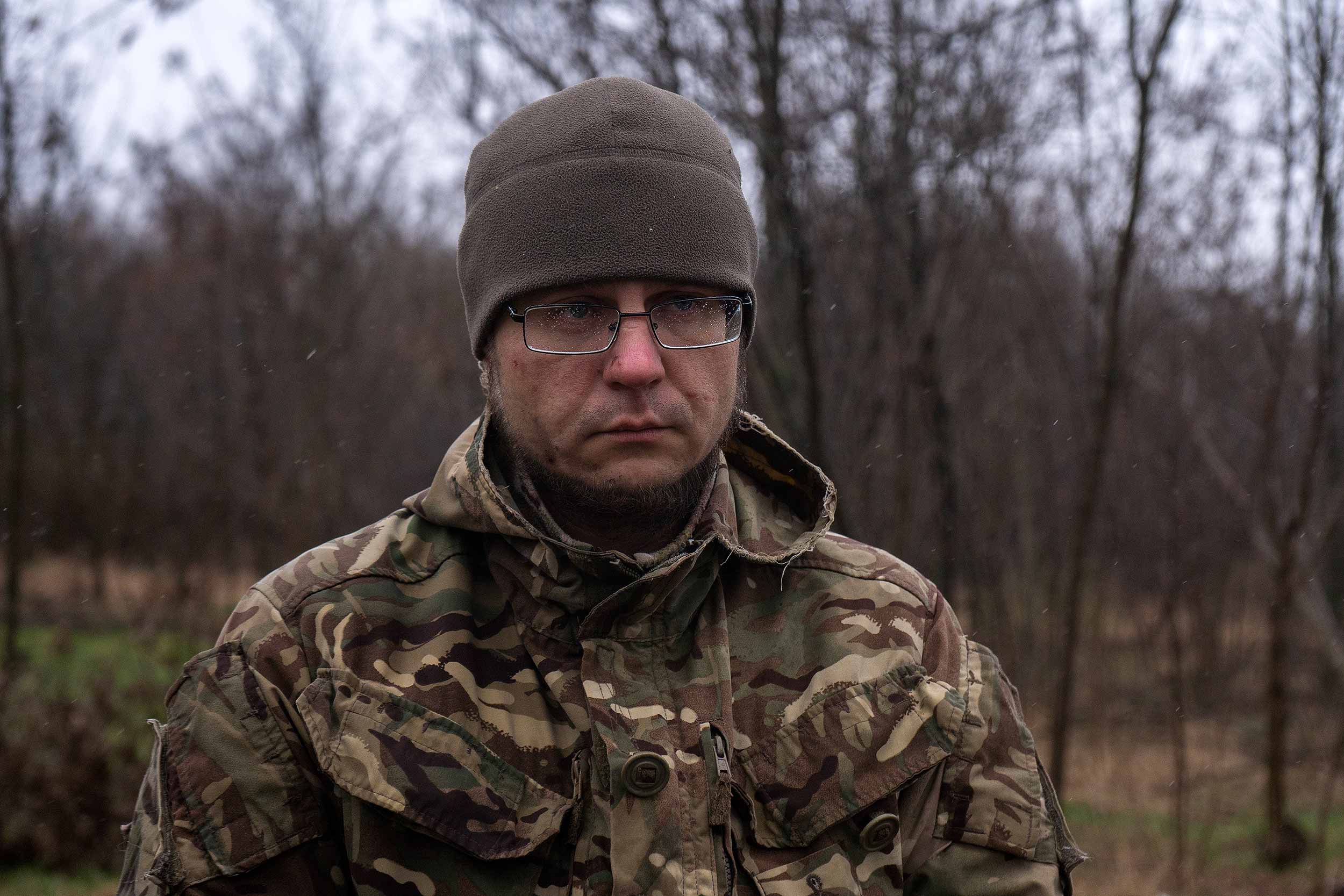The Ukrainian Unit Recovering Bodies of Fallen Soldiers
The J9 group is tasked with searching for the bodies of servicemen, including Russians.
Wrapped in thick fatigues and a wool green beret, Anton carefully examines a body in military uniform found in a forested area near Hrushivka, a village in Ukraine’s eastern Kharkiv region. The body is maimed, the head is missing; it could have been torn apart by wild animals, Anton suggests.
“The boots and uniform are Russian, that's all I can say,” Anton told IWPR, noting that this would be the 403rd body he has exhumed since joining the J9 military unit in May 2022.
Anton - call sign “the lawyer” - is an officer in the specialised unit operating under the central directorate of civil-military cooperation of the General Staff of Ukraine’s Armed Forces. One of its core tasks is to search for and collect the bodies of the fallen amid Russia’s full-scale invasion of Ukraine.

As J9 officers handle the body, Hrushivka resident Yevhen Chernyshov looks on.
“The bulletproof vest was lying ten metres away [from the body], and the helmet was nearby, the head was there recently,” said the 36-year-old, who found the body. “We didn't touch it. God knows, maybe it is mined.”
Hrushivka lies about 95 kilometres south-east of Kharkiv and the frontline is a mere 20 kilometres away. The hiss and explosion of artillery volleys echo regularly across the skies.
Chernyshov said the village was a target for Russian forces due to its proximity to Kupyansk, a strategic rail hub.
Like Kupyansk, Hrushivka was occupied in the first days of the war. Ukraine’s armed forces regained control of both in September 2022 during a major counteroffensive in the eastern front, but part of Kupyansk district remains occupied.
Of a pre-war population of nearly 1,200 people, only about a third remain. During the occupation, the only way out was through Russia, while since September residents have been able to flee in the direction of Kharkiv.
“All houses were intact during the occupation - our [Ukrainian soldiers] will not target our [homes],” Chernyshov said. “Then, in autumn, the village was liberated; the battle was on September 8, on the 20th we were heavily shelled for the first time: [people] were killed, children were injured. Since then the shelling has been happening periodically.”
Information about bodies or informal burial sites largely come from local residents, who often bury the dead to avoid them simply decomposing or being devoured by wild animals.
Once reported to the authorities, the bodies are exhumed and the identification process starts. If they are found to be soldiers of the Russian army, they are transferred for exchange.

Ksenia Samoilova, a local postwoman, pointed out a destroyed three-storey residential building, hit by a S-300 rocket in March 2023.
“People haven't lived there for a long time, so no one died,” the 54-year-old told IWPR.
Samoilova told the J9 team group about the bodies of two Russian soldiers spotted near a destroyed dormitory. However, the recent shelling covered them with debris and they cannot now be found.
“There were Russians there, whether they are still there, we don't know, the building collapsed and everything was buried,” Samoilova explained. “But there were two Russian corpses here…We asked whether it was possible to bury them, we were told not to approach them under any circumstances, because the bodies could be mined…it is very dangerous.”
She said that she hoped that the bodies of the soldiers under the rubble would be found and sent to Russia for exchange, adding, “I think that we differ from the Russians in humanity, the bodies should be buried in the ground, let their mothers bury them. And they need to be exchanged for our military.”

THE IDENTIFICATION
Anton, in his 30s, has served in the Ukrainian army for over a decade. When Russian tanks rolled into Ukraine on February 24, 2022 he joined the defence of Kharkiv and in late spring began working with the J9 in the recovery of bodies from the battlefield.
“Russians often leave their comrades on the territories regained by Ukraine, [we] exhume them from spontaneous burials, search for them in fields, forest plantations and send them for examination for further identification,” he said.
“In 50 per cent of the cases, it is possible to identify the body simply on the spot, through documents or bank cards. But it often happens that the Russian military takes the documents from the deceased to make his identification impossible.”
For the same reason, there are often no chevrons left on their military uniforms. The intention appears to be to obscure the Russian forces’ real losses and minimise the body count, which remains a sensitive issue. In addition, a soldier listed as missing enables Russian authorities to not pay benefits to his family
Wearing blue plastic gloves, Anton and his colleagues carefully place the body in a black bag and gather a few personal belongings; everything will be taken to the Kharkiv regional bureau of forensic medical examinations.
There were no documents found in the outer pockets of the uniform. The inner pockets will be examined at the morgue by forensic experts.
These state-run bureaux, present in all regional centres and a few small towns like Izyum and Kypyansk, are tasked with performing autopsies, determining the cause of death and issuing the statutory certificates.
Bodies are examined by an ad-hoc commission, with a representative of the J9, an Interior ministry criminologist, a police officer and an expert in forensic medicine present. After the superficial inspection of the body, the uniform and whatever documents are found, tissue samples are taken for DNA analysis and the body is stored.
Similarly to the J9, the commission is not engaged in an investigation. However, the result of the examination may become evidence in criminal proceedings, if they are initiated.
“We [recover] the bodies for three reasons,” Anton explained. “Firstly, it is for the very fact that the body of a serviceman of Russia’s Armed Forces is found on the territory of our land, [because] in the future, these materials will be transferred to an international tribunal. Secondly, I believe that the most important [reason] is for the exchange of bodies of Russian servicemen with [those of] our brothers, for our boys. And the third reason is environmental safety.”
Dozens of Russian bodies are often left behind, Anton added, recalling the liberation of Pisky-Radkivski, a village about 128 kilometres south-east of Kharkiv and 50 from Izyum.
“I took a Kamaz [large Russian-manufactured truck] to transport 66 bodies of Russian soldiers from Pisky-Radkivski,” Anton recalled. “[Russians] leave bodies for various reasons, as a result of the fact that there are active hostilities and they cannot take them away. But their main goal, of course, is to hide the real number of servicemen who died.”
He attributed Russia’s October 2022 missile strike on a refrigerated wagon in Kharkiv used as a body storage facility to this intent to conceal the scale of their losses. The bodies being held there were being prepared for exchange, Anton continued, adding that since then, the storage location is kept secret.
At the beginning of the war, the Russians did not agree to an exchange of bodies. The first such transfer took place on June 2, 2022, more than three months after the start of the full-scale invasion.
“Now body exchanges are taking place,” Anton said, noting that it was sometimes possible to swap the bodies of two Ukrainian soldiers for that of one Russian serviceman.
On March 2, 2023, Kyrylo Budanov, head of the Ukraine’s general directorate of Intelligence, said that the bodies of 1,409 fallen Ukrainian soldiers had been returned home.
“We have no right to miss such an opportunity, so we are taking the bodies of all the dead Russians for further exchanges,” Anton said.
The result of the DNA examination of the deceased is entered into the electronic register of human genomic information, a database operated by the interior ministry which stores information on all DNA samples of both the living and dead inside Ukraine.
“I want to appeal to the relatives of servicemen of the Armed Forces of the Russian Federation who are in Russia and are looking for their relatives…I am personally asking to appeal to our representatives and look for your loved ones,” Anton said. “They should understand that their close relatives died on the territory of our state.”
